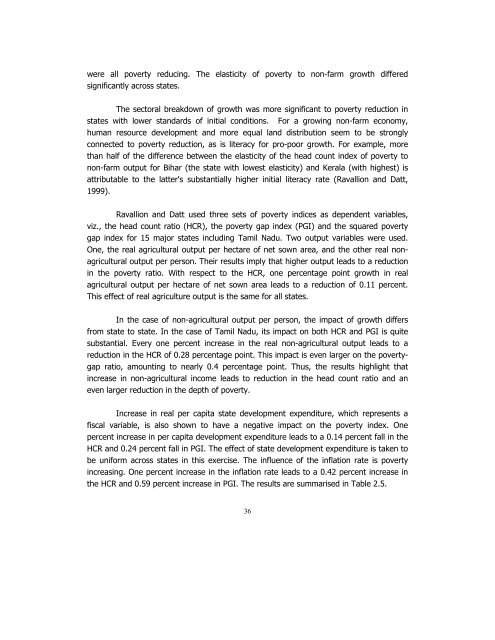POVERTY REDUCTION STRATEGY TN
You also want an ePaper? Increase the reach of your titles
YUMPU automatically turns print PDFs into web optimized ePapers that Google loves.
were all poverty reducing. The elasticity of poverty to non-farm growth differed<br />
significantly across states.<br />
The sectoral breakdown of growth was more significant to poverty reduction in<br />
states with lower standards of initial conditions. For a growing non-farm economy,<br />
human resource development and more equal land distribution seem to be strongly<br />
connected to poverty reduction, as is literacy for pro-poor growth. For example, more<br />
than half of the difference between the elasticity of the head count index of poverty to<br />
non-farm output for Bihar (the state with lowest elasticity) and Kerala (with highest) is<br />
attributable to the latter's substantially higher initial literacy rate (Ravallion and Datt,<br />
1999).<br />
Ravallion and Datt used three sets of poverty indices as dependent variables,<br />
viz., the head count ratio (HCR), the poverty gap index (PGI) and the squared poverty<br />
gap index for 15 major states including Tamil Nadu. Two output variables were used.<br />
One, the real agricultural output per hectare of net sown area, and the other real nonagricultural<br />
output per person. Their results imply that higher output leads to a reduction<br />
in the poverty ratio. With respect to the HCR, one percentage point growth in real<br />
agricultural output per hectare of net sown area leads to a reduction of 0.11 percent.<br />
This effect of real agriculture output is the same for all states.<br />
In the case of non-agricultural output per person, the impact of growth differs<br />
from state to state. In the case of Tamil Nadu, its impact on both HCR and PGI is quite<br />
substantial. Every one percent increase in the real non-agricultural output leads to a<br />
reduction in the HCR of 0.28 percentage point. This impact is even larger on the povertygap<br />
ratio, amounting to nearly 0.4 percentage point. Thus, the results highlight that<br />
increase in non-agricultural income leads to reduction in the head count ratio and an<br />
even larger reduction in the depth of poverty.<br />
Increase in real per capita state development expenditure, which represents a<br />
fiscal variable, is also shown to have a negative impact on the poverty index. One<br />
percent increase in per capita development expenditure leads to a 0.14 percent fall in the<br />
HCR and 0.24 percent fall in PGI. The effect of state development expenditure is taken to<br />
be uniform across states in this exercise. The influence of the inflation rate is poverty<br />
increasing. One percent increase in the inflation rate leads to a 0.42 percent increase in<br />
the HCR and 0.59 percent increase in PGI. The results are summarised in Table 2.5.<br />
36

















